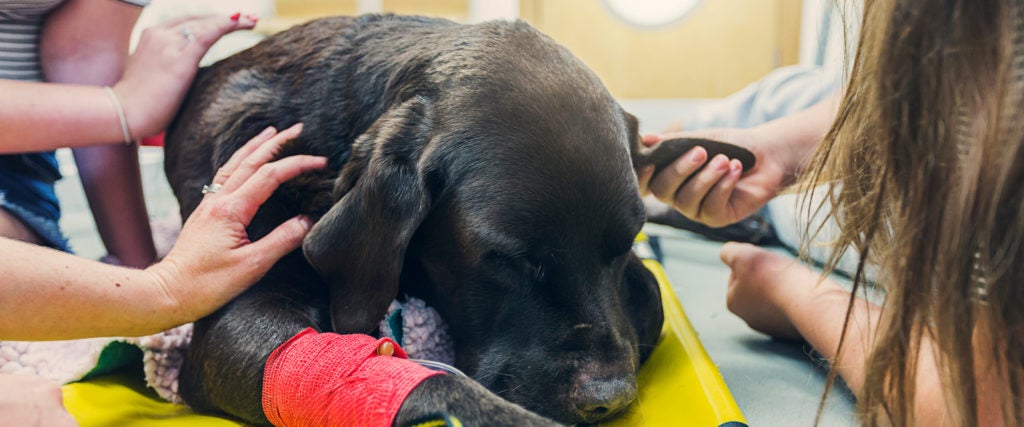It was about a decade ago that my sister brought home a black and white pitbull puppy. She was working at a clothing store when a man walked in holding the wee mongrel — he was moving soon and mentioned needing a new home for the dog. One thing led to another and my sister offered to take him. He came with the name Fargo, and she kept it.
Fargo was about the size of a shoe back then. He liked to zoom around my mom while she worked, grappling with her shoelaces and tangling them in the wheels of her rolling chair.
Just a few weeks ago, I saw a much bigger, much older Fargo, living a comfortable life with my parents. He brought me a single Croc when I walked through the door. It must have been my dad’s. Some things never change.
Fargo has been graying for some time now, so I saw it coming when my mom called me the other day to say he was sick. His glands are swollen like baseballs, he refuses to eat and he struggles to stand up. The doctors think he has lymphoma. Whatever it is, they say his time here is short and that euthanasia would surely save him some suffering.
- Read next: How do animal owners deal with pet debt?
My family has had to put down dogs before — several, in fact — but this time is different. Because of the coronavirus, veterinary hospitals have largely transitioned to curbside services, which could mean saying your last goodbyes from the car. And while many practices are making exceptions for euthanasia, Andrea Tu, medical director at Behavior Vets of New York, says there are still restrictions, like only allowing one family member to be present during the process, or requiring that they observe through a window. Disappointed by these options, my parents found another route: In-home euthanasia performed by an organization called Lap of Love.
The Lap of Love process is the same as euthanasia in a veterinary hospital, but from the comfort (and safety, because of coronavirus) of your home. In an email to my parents, Lap of Love explain, “We are here to help make the process as peaceful for you and Fargo as possible. Remember that you are giving him the gift of saying goodbye in the comfort of your home.” They also offer cremation services, but my parents are planning on taking Fargo to a nearby pet cemetery.
The euthanasia process, as Tu explains, typically involves sedating the animal, then injecting a euthansia solution, usually a medication called pentobarbital, which quickly shuts down the heart and brain functions. “The process is a lot quicker than most people realize,” she says. “Once the injection goes in, within a few seconds, the pet has passed.”
Having euthanasia performed at home has obvious benefits, especially if the coronavirus would otherwise prevent you from being in the room with your pet as it crosses the Rainbow Bridge. “I really want the last thing that a pet sees to be the people they know,” Tu says. “Then, the pet is able to look into their parents’ eyes before they go.” Plus, most pets are much more comfortable at home than at the vet, so it makes sense to have them pass away in their own beds, or wherever they like to hang around the house.
But there are also some potential downsides to in-home euthanasia: Tu says some of her clients have been left traumatized by the process, because the part of their home where their beloved pet undergoes euthanasia becomes a permanent reminder of when they passed away.
That said, euthanasia is really about our pets and their welfare, not ours. In a second email to my parents, Lap of Love send their condolences, but also emphasize the importance of bidding Fargo farewell before he gets much worse: “On a personal level, I want to assure you that we at Lap of Love are here to support you and your family during this time. We understand the ache of letting go of a precious family member. We also know it’s okay to say goodbye to Fargo on a good day. This helps ensure that he will ‘pass comfortably in his sleep,’ surrounded by all the loved ones he is most at peace with. We deeply believe that as hard as it is, saying goodbye to Fargo one minute — or even one day — too soon is better than a moment too late.”
Timing, of course, has always been one of the major troubles with euthanasia — in people, too. My parents already rescheduled the process once, because Fargo seemed to be doing somewhat better. Today, however, he seems to be doing markedly worse.
In the end, nobody ever really knows the perfect time to say goodbye. But for Fargo, I suspect he wants to go — in his bed and in his home — when he can no longer perform his favorite endeavor: Carrying shoes around the house.

